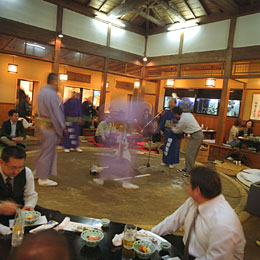
BIG APPETITES: Yoshiba's customers can eat--and pack on the kilos--like the pros
There's a reason that the training centers of sumo wrestlers are called stables—you need horse-sized quantities of food to keep a team of hungry sumo fed and fat. For centuries, the chief provision has been chankonabe, a protein-rich stew containing beef, chicken, pork, seafood, tofu, vegetables and just about anything else the stable master can find. (Traditionally, sumo eschewed beef and pork as meat that came from animals walking on all fours, symbolizing defeat in a match, but both meats are now consumed.) Chankonabe packs on lots of calories and, as sumo don't like to wait for their food, takes little preparation. Wrestlers will down multiple bowls during a long lunch, with rice and a few glasses of beer. And then they'll take a nice nap.
Those who wish to try out the sumo culinary regime can waddle over to Yoshiba in the Tokyo neighborhood of Ryogoku, close by the Kokugikan, the national sports arena that hosts the sport's most prestigious tournaments. Named after the late yokozuna (or grand champion) Yoshibayama, Yoshiba is housed in the former practice gym of the Miyagino stable—hence the full-size dohyo, or ring, that sits at the center of the restaurant. This has been known to host the occasional amateur match between drunken patrons, but it's all in good, bloated fun; the atmosphere at Yoshiba is family-friendly. A recent Saturday-night visit found pint-size sumo fans careering up and down the wooden floors, although it's amazing that anyone can move after tucking into the beef, chicken, seafood (or all three) chankonabe on hand. You cook the stew at your table in an earthenware pot, and you'll probably eat better than many sumo-in-training. Wrestlers eat in order of seniority at the stable, which means that the newest recruits get the dregs. A warning: thanks in part to their heavy diets, sumo are prone to heart disease and diabetes, and have a life expectancy that is more than 10 years shorter than the average Japanese male. Enjoy your chankonabe, but don't make a habit of it.
—by Bryan Walsh